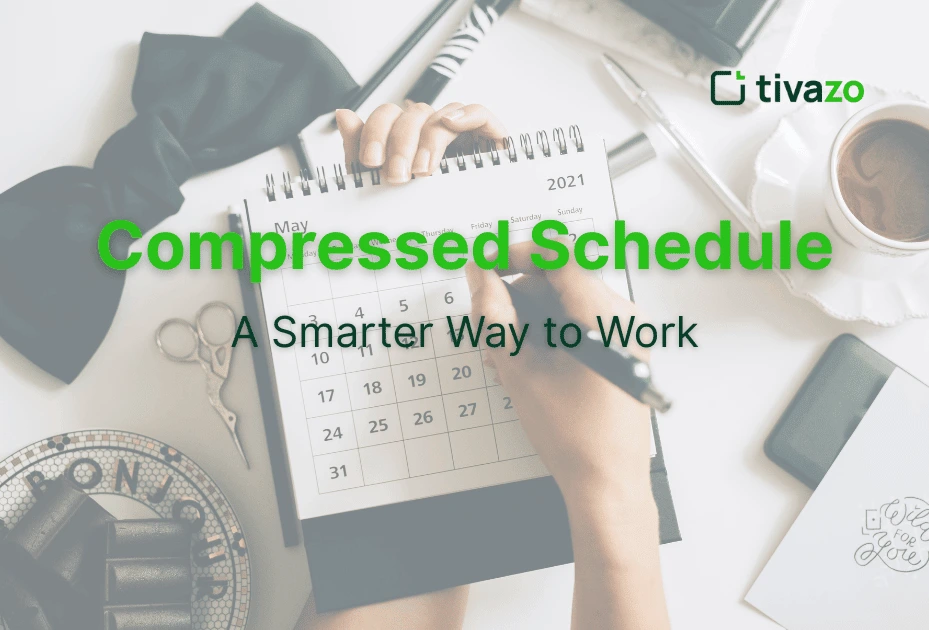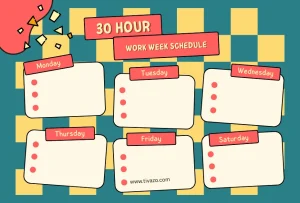Have you ever felt like the traditional 9-to-5, five-days-a-week grind just doesn’t fit your life anymore? You’re not alone. These days, many people at work are considering how to work smarter and turning to a schedule called the compressed schedule.
In this blog, we will look into the definition of a compressed schedule, why it’s being used more, its advantages and disadvantages, and how to make it work well. We’ll also bring up some essential facts, stats, and unique suggestions that other articles won’t offer.
Key Highlights:
- Why the Compressed Schedule is Booming in 2025
- Who Should Use a Compressed Schedule?
- How to Successfully Implement a Compressed Schedule
- Comparison Table: Compressed Schedule vs. Other Flexible Work Models
What is a Compressed Schedule?
A compressed schedule is when someone works a five-day workweek in fewer than five days. This way, instead of working 8 hours every day for 5 days, you might choose to work 10 hours each day for 4 days and spend 3 days off.
Per the U.S. Office of Personnel Management, compressed schedules are schedules where people still meet the 80-hour biweekly target, although they only work fewer than 10 days each week. Some of the usual formats in writing are
- 4/10 Schedule: Four 10-hour days per week
- 5/4-9 Schedule: Eight 9-hour days and one 8-hour day across two weeks, with one day off
Why the Compressed Schedule is Booming in 2025
Now that we are adapting to life and work after the pandemic, being flexible and having a balance are the most important things for workers. Gallup reported in 2023 that nearly half of the workforce chooses jobs that have flexible working hours.
On top of that, organizations that provide compressed schedules have noticed a rise in:
- Employee satisfaction
- Retention rates
- Overall productivity
Atlassian, a tech company known for workplace innovation, highlights how compressed schedules reduce burnout and foster higher engagement.
Advantages of a Compressed Schedule

1. Extra Day Off
A big advantage of having a compressed schedule is that you will get an extra day off. If you take that day off to relax, pursue activities you enjoy, shop, or spend time with family, it can greatly improve your life.
2. Fewer Commutes
Since you spend just one less day in the office, you save money and time on your commute. Based on the U.S. Census Bureau data, the average American round-trip commute takes about half an hour. It adds up to more than 200 hours that we can spend on other tasks.
3. Increased Productivity
Not having to stop often for meetings is one of the benefits of longer workdays. Employees usually dive more intensely into their work when they have a long time for a task. Several people report that by the end of the day, they feel they’ve achieved more.
You May Also Like: Top Tips to Maximize Your Work From Home Productivity
4. Better Work-Life Balance
The balance between work and life gets easier when individuals have more time for their duties and rest. The recruitment service Indeed reveals that reduced-hour schedules lead to fewer sick days and less time off being used by employees.
Disadvantages of a Compressed Schedule

Before you jump in, it’s important to weigh the potential downsides:
1. Longer Workdays Can Be Exhausting
Not all workers benefit from being at work for 10 hours each day. At times, tiredness may become a problem, mainly when jobs require lots of energy or thinking.
2. Scheduling Conflicts
Adjusting your timings to match everyone else’s usual schedules can sometimes be tough. It might hurt the way you collaborate and the expected delivery date.
3. Childcare and Personal Obligations
Since days are getting longer, it can create challenges for putting children in daycare or school, causing stress to parents and caregivers.
Who Should Use a Compressed Schedule?
A compressed schedule isn’t a one-size-fits-all solution. It works best for:
- Independent workers who require less real-time collaboration
- Remote employees or hybrid teams
- Industries like tech, marketing, and consulting, where project-based work is common
However, it may not be ideal for:
- Customer service roles need coverage during all business hours
- Healthcare workers or teachers with fixed schedules
How to Successfully Implement a Compressed Schedule
Ready to give it a try? Here are the best practices for a seamless transition:
1. Assess Your Workload
Schedule your tasks so that they fit into longer and longer working days. Try to have times in your day when you focus on important tasks.
You may Also Like: What Is the Task Prioritization Matrix?
2. Communicate with Your Team
Being truthful is very important. Talk to coworkers in advance and finalize an agreement on important meetings.
3. Use Tech Tools

Slack, Google Calendar, and Tivazo make it easier for communication and task tracking to be in sync.
4. Monitor and Adjust
Follow your achievements, personal well-being, and the opinions of your colleagues. If there are any issues, be ready to change the approach.
Compressed Schedule + Other Flexible Work Models: How They Compare and Complement Each Other
These days, employers care more about flexibility than other factors. Although the squeezing of work schedules into four days is more popular today, it represents only a part of the flexible work model trend. If we look at it together with other prominent workplace trends, we can grasp its role in the way our work is changing.
Let’s study what a compressed schedule has to offer as compared to the other alternatives and also how they can be brought together for better results.
Comparison Table: Compressed Schedule vs. Other Flexible Work Models
| Model | Definition | Key Benefits | Ideal For | Potential Drawbacks |
| Compressed Schedule | Full-time hours worked in fewer days (e.g., 4/10 or 5/4-9) | More days off, better work-life balance, reduced commuting | Personalized productivity accommodates personal obligations | Longer workdays, harder collaboration across teams |
| Flex Time | Employees choose their start/end times around a core set of hours | Isolation, timezone issues, and communication delays | Employees with peak-hour preferences, caregivers | Hard to coordinate meetings, and unclear availability |
| Remote-First | The company operates primarily online; employees can work from anywhere | No commute, access to global talent, higher autonomy | Tech companies, digital service teams | Work-life balance, skill-sharing, and part-time flexibility |
| Job Sharing | Two employees share responsibilities for one full-time role | Full autonomy and high performance, promotes trust | Working parents, semi-retired professionals | Requires perfect communication and handovers |
| ROWE (Results Only Work Environment) | Employees are measured solely on output—not hours or location | Full autonomy, high performance, promotes trust | High-performing teams, creative or analytical roles | Not suitable for client-facing or support roles |
Can These Work Models Be Combined?
Absolutely. A compressed schedule isn’t mutually exclusive with other flexible setups. In fact, when thoughtfully combined, these models can create ultra-productive and employee-friendly environments.
Here’s how:
- Compressed + Remote-First: Working four 10-hour days from home means fewer distractions, better focus, and more personal time. Ideal for deep work.
- Compressed + Flex Time: Employees can choose to start earlier or later within their 10-hour day, further tailoring the schedule to their peak energy times.
- Compressed + Job Sharing: Two part-time professionals can each work two long days, covering one full-time compressed role. Great for maintaining business continuity.
- Compressed + ROWE: The most advanced hybrid. Employees work longer hours over fewer days but are measured strictly on output, not time. This model rewards productivity without micromanagement.
Why Combine Work Models?
According to the 2024 LinkedIn Workplace Trends Report, 72% of employees prefer a job with several types of flexibility rather than just one kind. Companies get better chances to recruit talented employees, prevent exhaustion, and ensure staff stay by mixing work schedules and adapting as required.
Final Thoughts
A compressed schedule could be the game-changing work structure you’ve been looking for. When done thoughtfully, it can improve productivity, well-being, and even your career satisfaction.
But like any change, it needs to be personalized. What works for one team or individual may not work for another. Test, adjust, and stay open to evolving your work life.
If your workplace is open to innovation, now is the perfect time to pitch the idea. After all, in 2025, smarter work isn’t about working more, it’s about working better.
What is the best compressed schedule?
The 4/10 schedule is the most popular—four 10-hour days with a 3-day weekend. However, the best option depends on your job role and personal lifestyle.
Is compressed hours worth it?
Yes, for many people. It offers better work-life balance, fewer commutes, and more focused productivity—if managed well.
How do I calculate compressed hours?
Add your total weekly or biweekly hours (usually 40 or 80), then divide by the number of workdays you want. For example, 40 ÷ 4 = 10 hours per day.




